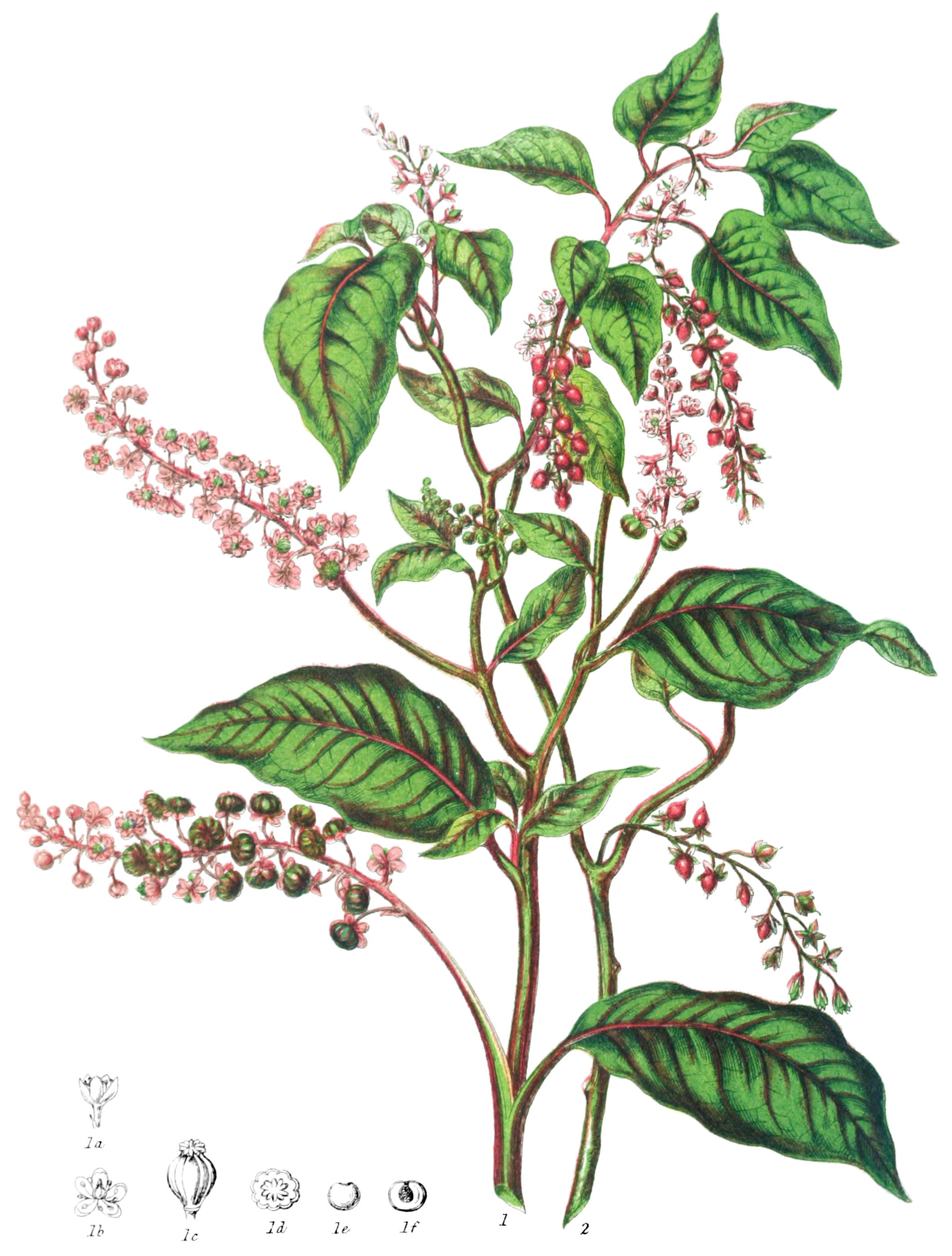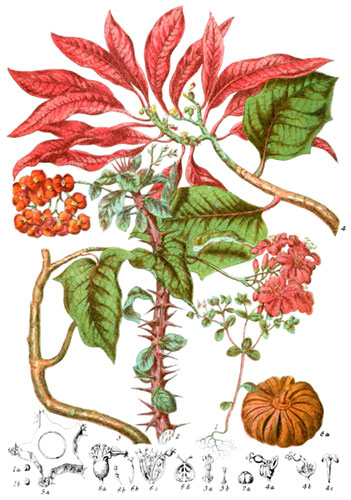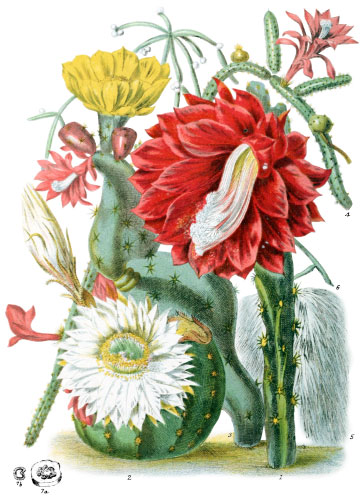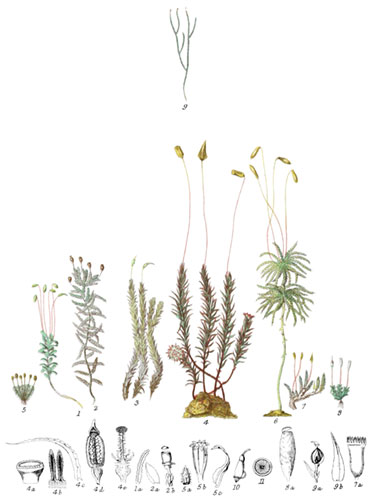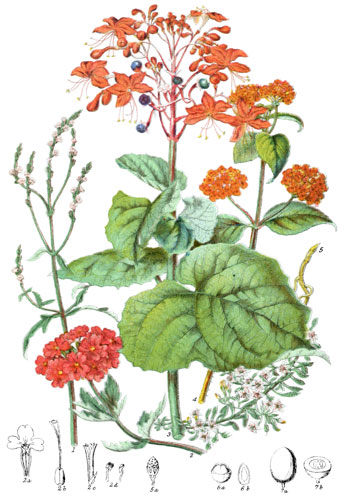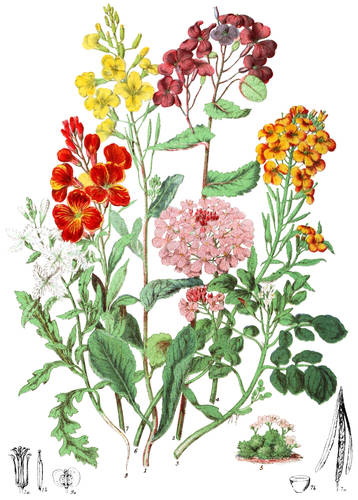Key characteristics
Undershrubs and herbaceous plants; the leaves are alternate, entire, without stipules, often having transparent dots. The flowers are racemes, perfect, regular, or partly irregular, arranged in various ways. The calyx is composed of four or five sepals; sometimes having the appearance of true petals, which are wanting. The stamens are fixed below the ovary, equal in number and alternate with the sepals, or of indefinite number. The anthers are two-celled, opening lengthwise. The ovary is of one carpel, or several distinct, or partially combined; the styles and stigmas are equal in number to the carpels. The fruit is dry or a berry, closed. The seed is solitary, and contains mealy albumen.
This Tribe is connected with Chenopodiaceæ and Polygonaceæ.
Acrid properties exist in various intensity in these plants.
Select plants in this order
Not all plants listed are illustrated and not all plants illustrated are listed.
- Phytolacca signifies a plant yielding a red lac colour, which the berries of P. decandra (1) do abundantly. It was the first species known in this country, having been introduced from Virginia early in the seventeenth century: the English name of Poke is derived from the Virginian Pocan. No use is made of it here, but it is very ornamentl, both in flower and fruit; graceful in form, and brilliant in hue. The juice of the berries has strong medicinal properties, and a spirit distilled from them is poisonous to animals; nevertheless, poultry feed eagerly on the fruit, without injury. In the United States, the young shoots, which sprout forth in great profusion in rich soil, are eaten, and considered excellent; the acrid properties being expelled by boiling. The root is large and branching, and when dried and pounded, is very similar in its effects to Ipecacuanha. If permanence could be given to the purple colouring matter, it might be valuable for staining paper or other materials. Since the introduction of the plant to the countries bordering the Bosphorus, it has been employed to give a bright colour to sherbet. It is said, also, that in Portugal the berries are extensively used to colour port wine; but they are not so wholesome for that purpose as those of the elder, which were some years ago forbidden by the government as an unlawful adulteration, and the bushes were all cut down.
- P. acinosa is ne of the medicinal plants of the Himalayas.
- P. drastica of Chile has a root shaped like a turnip, which is said to contain very powerful properties.
- Ravina was named after a Saxon, who was for many years professor of botany and medicine at Leipzig, and published several valuable botanical wors; some of his ingenious and original remarks on the distinguishing characters of the corolla of plants, have been incorporated by other authors in their writings. Ravina being a genus continually producing flowers and fruit, is a perennial honour to his memory and talens, as Linnæus remarked.
- R. tinctoria (2) is one of the numerous plants yielding colour in Brazil. It is of very elegant growth, and a pleasing ornament to the conservatory. The fruit contains one rough seed; the colouring substance of the pulp is a bright red.
- R. octandra abounds in Jamaica, and furnishes hoop-bands for sugar-casks, from it slong, tough, and flexible stalks. The berries, which contain oily seed, are the chief food of the American Thrush; but, as they are heavy of digestion, it is said that the bird, with true instinct, immediately seasons its repast with a few pods of the Capsicum baccatum, the Bird-pepper bush. The species are generally upright, but R. octandra is of a climbing nature, and twenty feet high.
- The seeds of the Ravina have only a small portio of albumen.
- Giesekia, with its separate ovaries, forms a link with Chenopodiaceæ.
- From the experiments of French chemists, it has been shown that the ashes of Phytolacca decandra contain a very large proportion of potash; the cultivation of it, therefore, in France, might probably be advantageous as a source of alkali.
Locations
some species of this Tribe are natives of North and South America, in the Tropical regions, and beyond the: others belong to India and Africa. Phytolacca decandra has become naturalized in some Southern countries of Europe.
Legend
- Phytolacca decandra, Virginian Poke. North America.
- Flower.
- Flower.
- Ovary and Pistil.
- Section of Ovary.
- Seed.
- Section of Seed.
- Rivina tinctoria, Dyer’s Rivina. Brazil.
Explore more
Posters
Decorate your walls with colorful detailed posters based on Elizabeth Twining’s beautiful two-volume set from 1868.
Puzzles
Challenge yourself or someone else to assemble a puzzle of all 160 botanical illustrations.
